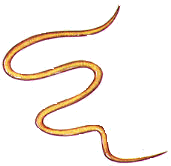Intestinal parasites in cats
Intestinal parasites are not always the first thing cat owners think about when considering their cat's health. However, it is estimated that approximately 50% of the cats in the UK will be infected with worms at some stage in their lives. For obvious reasons the risk of contracting an intestinal worm infection is higher with outdoor cats than the indoor variety. Nevertheless, indoor cats are not completely protected - worm eggs can get into households in a number of ways, and owners of indoor cats are less aware of the risks. Early clinical signs of parasitic infection are not obvious, and many cats show no signs at all. However, if a cat seems a bit off colour, suffers from intermittent diarrhea, or does not gain weight, despite a healthy appetite, then it might be that a parasitic infection is to blame. Checking for parasitic infections is even more important since some of the parasites are a potential health risk to humans as well.
 |
Types of Parasites
Roundworms - Toxocara cati and Toxascaris leonina are the most common roundworms affecting cats. They can get up to 10cm long and are thin, white, spaghetti-shaped creatures. Under suitable conditions (for example in soil) the eggs can survive for years. Cats can be infected by directly ingesting eggs, or indirectly by eating infected rodents. World-wide it is estimated that 1 in 5 cats carry Toxocara cati worms in their intestines. Unless the system is riddled with worms, adult cats seem remarkably unaffected and show few, if any, signs of illness. However, an infected mother will pass the infection to suckling kittens through her milk and thus infect her offspring - and roundworm infection can make a kitten seriously ill. Cats with a heavy worm burden may vomit up the worms or pass them out of their body with bowel movements. Some infected cats seem are generally off colour, may become potbellied and be persistently hungry. There is a risk, though slight, to humans who accidentally swallow toxocora eggs. In humans the eggs can travel in the bloodstream to the eye, where they infect muscle tissue. The infection is known as "Visceral Larva Migrans" and, if untreated, can cause blindness.
Toxascaris leonina is much less common than toxocara cati, and is not passed to the kitten in the milk. It is very rare that cats younger than 6 months are infected with this worm.
Hookworms - Ancylostoma species are the most common form if worm infection in cats. Hookworms are too small to be seen by naked eye. They occur in warm, more humid countries, for example Australia, New Zealand, South Africa and in parts of the USA. They are rare in the UK. The parasites are bloodsuckers and can cause anemia in infected animals. Veterinary treatment is essential as cats infected with hookworms can develop chronic intestinal bleeding, abdominal pain and diarrhea. Hookworm can also infect humans. The larvae burrow into the skin, causing "Cutaneous Larva Migrans" which is characterised by a red line of inflammation which is intensely itchy. In small children, as in cats, hookworm infection can cause intestinal bleeding and abdominal pain.
Whipworms - more commonly infect dogs than cats. As with hookworms, these are more common in warmer countries. The worm lives in the upper section of the large intestine and it is rarey passed out of the body in bowel movements. The worm sheds relatively few eggs which means that diagnosis is difficult.
Tapeworms - Dipylidium caninum and Taenia taeniaeformis are the most common tapeworms in cats. Dipyliduim caninum is transmitted by a cat eating infected fleas or lice whilst grooming. Taenia taeniaeformis is transmitted to cats through infected prey. Tapeworms are shed as segments which have broken off from the adult parasite. These segments are the size of uncooked grains of rice and they can be easily seen by the naked eye. The segments are white and can be seen around the cat's rectum if the cat is infected. Once the segments die they are shed and can be spotted on or near the place where the cat sleeps.
Toxoplasma gondii - infects the cells which line the intestines. It rarely causes symptoms in cats but it is dangerous to humans. Cats can get this parasite from eating infected meat if that meat is raw or undercooked, or by eating infected prey. The eggs from this parasite are passed out in the faeces of an infected animal. These eggs infect other animals which ingest them, including humans. Pregnant woman are most at risk of contracting the disease. The best protection is to wear gloves when handling cat litter.
Although signs of illness are rare in cats, a heavy parasitic burden will cause vomiting, high temperature and diarrhoea. Some cats may develop pneumonia and heart and liver disease.
Coccidiosis (Isospora felis ) - Coccidia is one of the most common parasites in cats. This often affects kittens and is more likely to be found in overcrowded households with poor sanitation. The parasites infect the intestinal lining where they reproduce. The reproduction cycle takes about a day, after which the parasites kill the infected cells and are shed in the cat's faeces. Infected kittens may exhibit weight loss, weakness, dehydration and diarrhea with possibly blood and/or mucus being present. The older cats rarey show any clinical symptoms.
Note: This information is for guidance only. It is not intended to replace consultation with a licensed practitioner.

